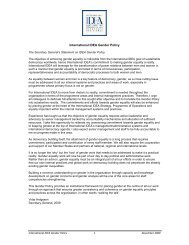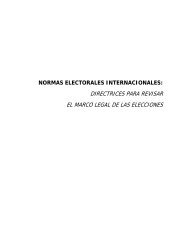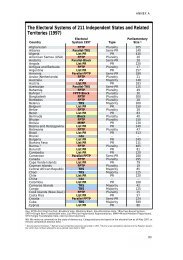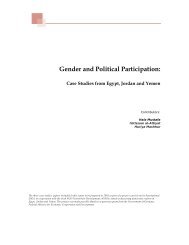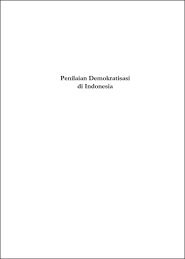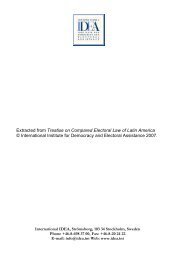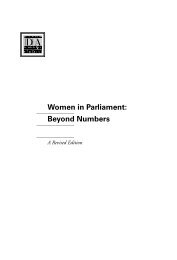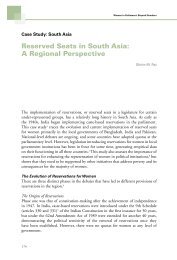The Role of State Constitutions in Protecting ... - International IDEA
The Role of State Constitutions in Protecting ... - International IDEA
The Role of State Constitutions in Protecting ... - International IDEA
Create successful ePaper yourself
Turn your PDF publications into a flip-book with our unique Google optimized e-Paper software.
dependent than ever on revenue redistribution, for which the Constitution makes<br />
no clear provision, other than allow<strong>in</strong>g grants <strong>of</strong> f<strong>in</strong>ancial assistance to be made.<br />
As a result, the <strong>State</strong>s rely on the Commonwealth government and Parliament to<br />
decide the amount that will be made available to them each year and the basis on<br />
which that amount will be determ<strong>in</strong>ed. Systems that have been used for this<br />
purpose over the years <strong>in</strong>clude formula based arrangements, tax shar<strong>in</strong>g <strong>of</strong> various<br />
k<strong>in</strong>ds and commitments to match the previous year's grant levels. Under current<br />
arrangements, the Commonwealth makes available to the <strong>State</strong>s the proceeds <strong>of</strong><br />
the federal Goods and Services Tax. Some grants are also made on condition, that<br />
they will be spent <strong>in</strong> a particular way. Through the use <strong>of</strong> these grants, the<br />
Commonwealth <strong>in</strong>fluences policy <strong>in</strong> a range <strong>of</strong> areas <strong>of</strong> <strong>State</strong> responsibility that<br />
require significant expenditure <strong>in</strong>clud<strong>in</strong>g education, hous<strong>in</strong>g, health and<br />
transport.<br />
Revenue redistribution from the centre to the <strong>State</strong>s <strong>in</strong> a federation typically has<br />
two aspects. <strong>The</strong> first aspect concerns the total amount to be distributed to the<br />
<strong>State</strong>s. <strong>The</strong> second concerns the manner <strong>in</strong> which the total will be allocated<br />
between the <strong>State</strong>s. Australia and many other federations divide such funds<br />
between <strong>State</strong>s with the assistance <strong>of</strong> “fiscal equalisation” pr<strong>in</strong>ciples. In Australia,<br />
the goal is to put each <strong>State</strong> <strong>in</strong> a position <strong>in</strong> which it can <strong>of</strong>fer broadly comparable<br />
services to the other <strong>State</strong>s, without unduly rais<strong>in</strong>g its own taxes and charges. To<br />
this end, an <strong>in</strong>dependent body, the Commonwealth Grants Commission,<br />
recommends “factors” by which the population <strong>of</strong> each <strong>State</strong> should be weighted,<br />
<strong>in</strong> distribut<strong>in</strong>g federal funds. <strong>The</strong> factors are calculated by reference to <strong>State</strong><br />
revenue disabilities and expenditure needs. <strong>The</strong> Grants Commission's<br />
recommendations are almost always accepted. <strong>The</strong> system is complex, however,<br />
and the pr<strong>in</strong>ciple <strong>of</strong> fiscal equalisation itself is <strong>in</strong>termittently under attack from<br />
the richer <strong>State</strong>s, which receive less per capita than the others.<br />
It is important to note that the general revenue funds that are distributed between<br />
the <strong>State</strong>s <strong>in</strong> accordance with fiscal equalisation pr<strong>in</strong>ciples are not subject to any<br />
conditions. In particular, a <strong>State</strong> is not required to spend the funds on the<br />
“expenditure needs” by which its <strong>State</strong> factor was calculated. This feature <strong>of</strong> the<br />
system is also criticised from time to time. On the other hand, there is a sense <strong>in</strong><br />
which it provides a good illustration <strong>of</strong> how the comb<strong>in</strong>ed pr<strong>in</strong>ciples <strong>of</strong> unity and<br />
diversity can work <strong>in</strong> a federal system. <strong>The</strong> pr<strong>in</strong>ciple <strong>of</strong> unity suggests that it is fair<br />
for <strong>State</strong>s that are poorer to receive more than the richer <strong>State</strong>s and, <strong>in</strong> effect, for<br />
the latter to assist the former. <strong>The</strong> pr<strong>in</strong>ciple <strong>of</strong> diversity, however, suggests that<br />
neither the centre nor the richer <strong>State</strong>s should tell the others how to spend the<br />
funds that they have received. In a federal system, they should be able to<br />
determ<strong>in</strong>e expenditure priorities for their own communities, by democratic<br />
means, through democratic <strong>in</strong>stitutions.<br />
39




